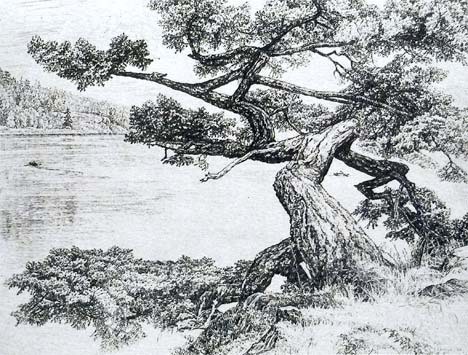The San Juan Islands Museum of Art & Sculpture Park (IMA), at 28 First St. in Friday Harbor, will open “A Retrospective of Helen Loggie, 1917-1952,” Jan. 29, 5-8 p.m.
Helen Loggie, a nationally recognized artist, lived most of her life in Bellingham and on Orcas Island. This exhibition links San Juan Island and Orcas Island in a unique manner, for The Lambiel Museum on Orcas is loaning part of its Helen Loggie Collection of more than 100 pieces, the largest private collection in existence, to IMA for an exhibit that will run through March 7.
Loggie was born and raised in Bellingham, studied at the Art Students League in New York City followed by trips to Europe, and in the late 1920s returned to her home in Bellingham.
In the early 1930s, she had a house of her own design built on Orcas Island, a place that had very special meaning for her and would become the main focus of her work in later years.
It was here in the Northwest that she created many of her acclaimed drawings and etchings. Throughout her career, there have been exhibitions of her work including solo exhibits at the Smithsonian Institution in Washington, D.C., the Frye Museum in Seattle, and at the Whatcom Museum of Art and History and the Western Gallery at Western Washington University, both in Bellingham.
The IMA exhibition is divided into two sections: Gallery I will include drawings and etchings from her student years in New York with portraiture, dynamic city scenes and St. Patrick’s Cathedral, along with vibrant oils, drawings and etchings of magnificent cathedrals, bridges and fishing boats from her European travels.
Gallery II will focus on her transition back to the Northwest with drawings, etchings and oils depicting ships in Bellingham Bay, sawmills and even circus animals, but most importantly, her exquisite images of mountains, islands and trees, particularly her beloved old, gnarled trees of Orcas Island. The exhibit will also display some of her sketchbooks, etching tools and a collection of Christmas cards.
Loggie scorned abstract art and focused on realistic detail for which she became famous. Even though she dabbled in oils, her preferred medium was pencil drawing. The brochure for the Western Gallery exhibit quoted from a 1939 newspaper: “For her drawings, Miss Loggie uses three pencils, hard, medium and soft. When she goes out sketching, we are told, she takes with her a dozen pencils of each variety, all carefully sharpened, so she will not have to interrupt her work to repoint them.”
Her pencil drawings of trees especially illustrate the intricate lines, e.g. of bark and the grasses on the ground below, which became her signature.
During the first half of the 20th century, current methods of reproducing art did not exist, so she became skilled at the process of etching in order to make copies of her work. Her drawings were particularly suitable for etching and she explored ways to develop contrasts in the etchings to avoid a monotone appearance.
Vicki Halper, author of the Loggie Exhibition brochure at the Frye Museum, quotes Loggie as saying: “If I had known how hard etching is, I would never have started.” However, the etching process was essential for her to share and distribute her work and she persisted in honing her skills. A description of the etching process will be part of this exhibit for one of the goals of IMA is be an educational avenue in the arts.
Ann Friedman, author of the essay accompanying the Helen Loggie exhibition at Western Gallery in 1993, quotes Loggie: “If I could strike an answering spark, especially in the hearts of the young people, so that they would realize that natural beauty is the greatest heritage the West has to give her children, so that they would protect what remains of our Northwest … then I would indeed feel that the years have been well spent.”




